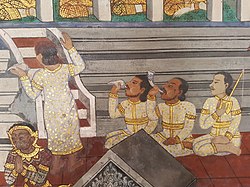Annual report of the Bureau of American Ethnology to the Secretary of the Smithsonian Institution (1897) (14784143102)
Identifier: annualreportofbu219smit (find matches)
Title: Annual report of the Bureau of American Ethnology to the Secretary of the Smithsonian Institution
Year: 1895 (1890s)
Authors: Smithsonian Institution. Bureau of American Ethnology
Subjects: Smithsonian Institution. Bureau of American Ethnology Ethnology Indians
Publisher: Washington : U. S. Govt. Print. Off.
Contributing Library: Boston Public Library
Digitizing Sponsor: Kahle/Austin Foundation and Omidyar Network
View Book Page: Book Viewer
About This Book: Catalog Entry
View All Images: All Images From Book
Click here to view book online to see this illustration in context in a browseable online version of this book.
Text Appearing Before Image:
tic at Walpi 977 LII. Supela at entrance to Walpi Snake ki\-a 978 LIU. Antelope altar at Walpi 981 LI V. Kakapti at entrance to Waljii Atitelope kiva 982 L\. Antelope priests of Walpi 985 LVI. Crypt in which snake jars are kept at Mishongnovi 986 LVII. Cakwalenya society of Mishongnovi 993 LVIII. Macileiiya society of Jlishongnovi 995 LIX. Macileiiya society of Jlishongnovi 997 LX. Platoons of Fhite priests marching from the spring to Mishong-novi , 999 LXI. Leiiya (Flute) children of Mishongnovi (front view) 100) LXII. Lenya (Flute) children of Mishongnovi (rear view) 1002 LXIII. Flute children of Mishongnovi throwing offerings on rain-iloud symbols 1005 LXIV. First Flute altar at Walpi 1007 LX V. Cakwalenya altar slabs at Walpi 1009 Figure 42. Diagram of positions of celebrant.* in the Snake washing 971 43. Altar of the Macileiiya at Mishongnovi 990 44. Altar (if the Cakwalefiya at Mishongnovi 991 45. .Plan of Flute room at Walpi 1000 46. Core of Flute tiponi 1004 96119 KTH, PT 2 26
Text Appearing After Image:
NOTES 0^ TUSAYAN, SXAKE, AND FLUTE CERE3I0XIES By Jessk Waltkk Fewkes INTRODUCTION Tho Hopi or so-called Moqui Indians of Arizona are among the fewsurviving tribes of American !i))origines which still retain an ancientritual that is apparentl)^ unmodified by the Christian religion. Thisritual is of a very complicated nature and is composed of monthlyceremonies the recurrence of which is precise as to time and place. It must be remembered that these ceremonies are not performed atirregular intervals by well-to-do Hopi to cure sickness of themselvesor their families. Among other Indians this motive is often thekeynote of their rites, but while among the Hopi there are ceremonialswhich are directed to that end. and all the regularly recurring cere-monials are regarded as eHicacious in healing bodily ills, they haveprimarily another purpose. Whether they originated as a preventiveof disease, and in their primitive condition had the same intent as therites of the Navaho shamans, is beyond
Note About Images
Relevante Bilder
Relevante Artikel
SchneckenhornSchneckenhorn, auch Schneckentrompete, ist eine aus dem Schneckenhaus einer großen Meeresschnecke gefertigte Naturtrompete, die seit der Jungsteinzeit für religiöse Rituale, als Signalinstrument vom Militär und von Fischern und seltener in der Musik verwendet wird. Die Bezeichnungen Muschelhorn oder Muscheltrompete sind irreführend, da es sich bei keiner Art zoologisch um Muscheln handelt. Instrumentenkundlich ist es ein Blechblasinstrument, da sein Ton mit den vibrierenden Lippen gebildet wird, vielleicht das älteste. Schneckenhörner werden längs oder quer geblasen, manche besitzen ein Mundstück aus Metall oder Holz und sind mit Gravuren oder Metallfassungen dekoriert. .. weiterlesen






















